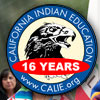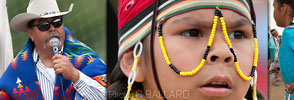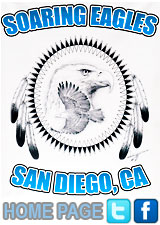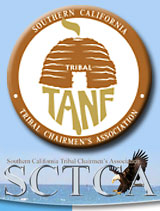 |
 |
 |



Publishing Corner: Indian Community: Science & Wonder Indian Heros: California Indian Art: CALIE Library: Academic Financial Aid: Tribal Governments: Indian Gaming: |
CULTURAL HISTORY AND INFORMATION ABOUT NATIVE AMERICAN POW WOWS IN SOUTHERN CALIFORNIA
LEARN PROTOCOL & HOW TO POWWOW DANCE
CALIE offers extended free pow-wow dancing and regalia-making classes for urban and reservation children — kindergarten through 12th grade. Please visit the link for more information, including professional photo and story blogs and PRESS RELEASE about the participating Native American families and students. Please visit ROY COOK's Large Story & Picture Blog on the Soaring Eagles summer classes and witness all the Indian family fun pictures.
Young Native American children attend the cultural classes with their families and friends to learn about their Indigenous tribal dance protocols to participate in traditional California Indian gatherings and powwows like the 2008 Barona Traditional Gathering, and the Sycuan Traditional Gatherings on Southern California Indian reservations.
POW-WOW REGALIA
For beautiful professional San Diego pow-wow and traditional California Indian regalia picture albums of modern tribal regalias and Kumeyaay fiesta pictures please visit the on-line kumeyaay.info professional photography pow-wow gallery. Beautiful digital portfolio includes tribal designs of top professional pow-wow dancers and exhibits tribal face paint cultural regalias from across the USA, Canada, northern Baja California Mexico tribes, including the Diegueño Kumeyaay Kumiai, Mohave, Quechan, Cocopah, Juaneño, Cahuilla, Pai Pai, Ipai Tipai, Hualapai, Kiliwa, Havasupai, Maricopa, Yavapai and Luiseño Indians of the southwest United States of America.
Watch a 2002 POWWOW MOVIE short of California Indian bird singers and bird dancers performing in a local Southern California pow wow. +++++++ Following text submitted by Roy Cook, Opata-Oodham, Mazopiye Wishasha: Writer, Singer, Speaker. Ladies Cloth Dress This style of dress has many different looks. Many of the Eastern & Southeastern tribes wear long full cotton dresses, or skirts worn with cape-like blouses. Many women of the Woodland tribes wear a form of appliqué on their skirts and shawls called "ribbon-work". This term refers to wide bands of appliqué that were originally created by using brightly-colored wide silk ribbons, layered on top of each other, with designs cut out of the topmost layers. Many of the Plains and Plateau tribes wear T-dresses, an "Indian" version of a one-piece A-line dress with large open sleeves, which may have intricate designs sewn or beaded onto them. Southwestern tribes such as the Navaho are often distinguished by an abundance of turquoise and silver jewelry. The styles worn by women are the most tribal-distinctive clothing seen in the pow-wow circuit. A knowledgeable person can often determine the tribe of the wearer by her outfit. Many dancers dance with very dignified, graceful steps. Some of the Northern tribes will dance in place, doing a graceful "bounce" to the rhythm of the drum. Ladies dressed in cloth may or may not wear eagle plumes or feathers, and otter-fur hair extensions, depending on their tribe's style and personal preference. Ladies Buckskin Dress There are two distinct styles in this category, Northern and Southern. A Southern buckskin outfit consists of a partially beaded skirt; top, high top boot moccasins, a southern-style purse, dance shawl, and a feather dance fan. The dancers often wear chokers, beaded hair ties and fur hair extensions. The styles of beadwork differ greatly among the tribes, and although these dresses may have extensive beadwork, the tops are not fully beaded. Modern dresses have very long fringes hanging from their sleeves. Southern dancers will dance with very dignified, graceful steps around the arena. Most of the Northern-style dresses have fully beaded tops, and are often worn with fully beaded moccasins and separate leggings. The tops have very long fringes hanging from their sleeves, and the dancer will generally carry a fully beaded purse, a dance shawl, and an eagle feather fan. Occasionally, a Northern dancer will have a wool broadcloth skirt instead of a skin one, or have a cloth dress top that appears very similar to a fully beaded top. Many of the Northern dancers will dance in place, doing a graceful "bounce" to the rhythm of the drum. Most wear eagle plumes and/or an eagle feather in their hair, and usually wear chokers, beaded hair ties, and otter-fur hair extensions. Ladies Fancy Shawl This is a modern style of dance, introduced in the 1960’s, when it was often called "Graceful Shawl". The story I’ve heard is that the women were so moved by the music, that they began to dance in a more energetic style, some saying that their open shawl represents the wings of a butterfly. It is very popular among the younger girls and women. They wear a yoke or vest/yoke combination that is either beaded or elaborately-appliquéd or sequined, a flared knee-length skirt, and a shawl opened wide over their shoulders and held at the edges in both hands. They also wear leggings that are beaded or elaborately-appliquéd cloth or sequins, and beaded moccasins. They usually wear eagle plumes and/or feathers, and long ribbon streamers hanging from their beaded hair ties. Ladies Jingle Dress This dress originated with the Ojibway tribes in Canada, but has spread throughout pow-wow country. It is often called a "medicine" dress, as it was originally conceived in the vision of a medicine man, as a means to heal a dying girl, who recovered and lived to an old age. This dress is made with hundreds of small rolled tin cones, originally made from Copenhagen tobacco tin lids, sewn into rows on the dresses. They make a beautiful soft "swishing" noise as the ladies dance, and these dresses are quite heavy. Most dancers today still respect the origins of this dance, and ask for permission from a member of one of these original tribes to wear this dress. In the Northern country, ladies will still dance this style clear into there seventies. Men Grass Dance This is a very old, traditional dance, whose origins go back long before memory. Some say these dancers originally flattened the tall prairie or buffalo grass for an upcoming dance, or for a new campsite for the tribe. Others say it originated with warriors sneaking up in the tall grass. Whatever the origins, it is a popular and colorful dance today. The dancers wear shirts or yokes and long aprons, with yarn or ribbon sewn onto them to resemble long grass tufts. Their dance is supposed to imitate the grass blowing in the breeze, long and willowy, with fairly graceful swaying movements. They wear pants with yarn sews onto legs also, and may wear a breastplate, loop necklace, or beaded "harness" in front. A porcupine hair roach, eagle feather fan, and neck scarf completes the outfit. Men Fancy War Dance This is a modern style, often said to represent the modern pow-wow. It originated in the "Wild West" shows in Oklahoma around the turn of the century as a showy, attention-getting spectacle for the trainloads of crowds from eastern cities who traveled to Oklahoma to see what was left of the "wild frontier". All of us ‘Okies’ know who the original dancers were, and their fame lives on long after their passing. This is a very fast, energetic style danced by mostly younger men. The dancers wear two bustles, one at the waist and one at the back of the shoulders. These may be eagle feathers, or colorful dyed feathers with ribbon or horsehair streamers hanging from the tips of the feathers. They usually dance to "trick" songs that have abrupt stops, trying to "trick" the dancers into messing up and over-stepping the end of the song. The dancers wear porcupine hair roaches with "rockers", a roach-spreader with two eagle feathers attached upright to a "rocker" that is supposed to rock back and forth continuously as the dancer spins and twirls. Originally, these dancers wore elaborate feather roaches, but these are rarely seen today. The newer, Northern take on this dance is to wear a "spinner" roach spreader with feathers that "spin" instead of "rock", and the songs are slower without the abrupt starts and stops of the original Southern style. You will often hear contest songs of both types today, and these dancers are often required to dance many, many songs to prove out their endurance, like a racehorse. Men Southern Straight or Southern Traditional This dance is widely known as "The Pride of Oklahoma", and is often announced as such at pow-wows. This graceful, dignified style comes from the dances done by the warrior societies of old. As they dance the dancer "tells a story", tracking his prey or enemy, pointing to tracks along the way. The traditional style of this dance is smooth and graceful, and the dancer is supposed to land on the left foot on the last beat of the song. Often a jerky, aggressive hopping or skipping is sometimes seen today is done by unknowledgeable dancers, or those determined to catch the attention of the judges in a contest. The outfit consists of front and back knee-length wool broadcloth aprons and a back "tail" which hangs to the ground. An "otter" or "hair plate" drop is worn down the back, extending from the neck to the ground, trailing behind the dancer. Cloth or buckskin leggings are worn over close-fitting bike shorts (a "breechcloth" going between the legs is never worn by real Indians at pow-wows today). The dancer may wear a traditional ribbon shirt, a vest, bandoliers and a bone breastplate. Headgear of a porcupine-hair roach or otter turban and a neck scarf completes the outfit. Also a dance stick and eagle feather fan is carried, and a "tobacco" pouch may be carried to hold cigarettes, money, and keys. Men Northern Traditional This is the Northern equivalent of a Southern Straight dancer, with a few important differences. Northern traditional dancers may wear skin aprons instead of wool, and they don’t have the long "tail" attached to their aprons like a Southern Straight dancer. A trailer is attached to their eagle feather bustle, which is worn at the back of the waist. Most wear fully beaded side-drops over their aprons. Their leggings, if worn, are usually made of skins. They may wear ribbon shirts or vest, beaded yokes, breastplates, and a porcupine-hair roach. Some tribes may wear an eagle or hawk-feather cap, or an appropriate animal skin as a headdress. They dance with an eagle staff, war lance, or the like, a shield, and an eagle-feather fan. They dance in a rather aggressive manner, in step with the drum, telling the story of a battle or tracking a prey as they dance. They will often be featured doing a "sneak-up" dance, crouching before the attack. Some people say this dance style originated with he Omaha tribe in Nebraska. Finally, you may want to see very good images of recent pow wow regalia and the source for much of this regalia information: |
CALIF INDIAN EDU NETWORK: AHMIUM.org | SDICENTER.org | APAPAS.com
—
WEB SITE DESIGN
www.calie.org COPYRIGHT 2008-Present • ALL RIGHTS RESERVED






